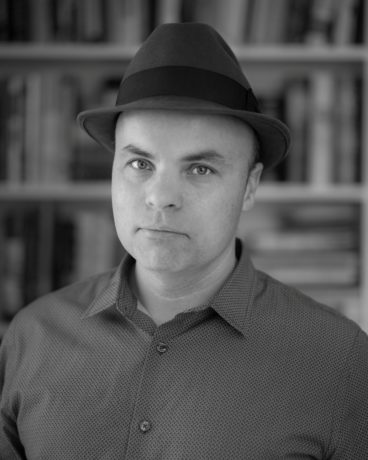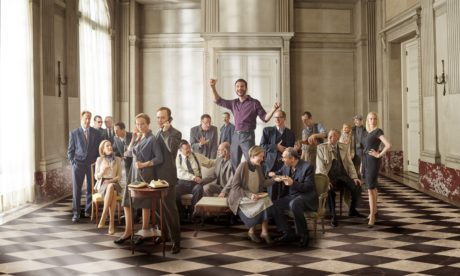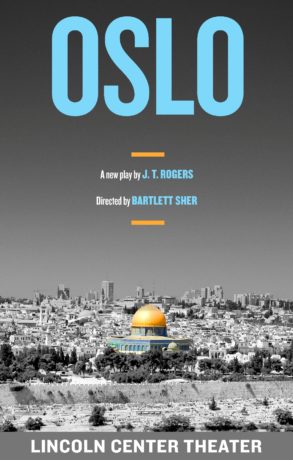Following its development in 2015 at PlayPenn — the respected thirteen-year-old Philadelphia-based artist-driven organization dedicated to supporting and fostering new work — playwright J.T. Rogers’ Oslo is Broadway bound, scheduled to begin previews at Lincoln Center’s Vivian Beaumont Theater on March 23.

The latest play by the award-winning writer, whose previous works include Madagascar (2004) and White People (which had its world premiere with the Philadelphia Theatre Company in 2000), recounts the backstory of the Oslo Accords, when the young Norwegian diplomat Mona Juul and her husband, social scientist Terje Rød-Larsen, orchestrated the top-secret meetings that led to the historic peace agreement between Israel and the Palestine Liberation Organization in 1993.
Rogers and PlayPenn’s Artistic Director Paul Meshejian were gracious enough, during this busy and exciting time before the New York opening, to give us their personal perspectives on the background process of taking the play from page to stage.
Deb: Has ‘Oslo’ been your biggest success to date?
Paul: I guess that depends on how you define success! We’ve developed over 100 plays in the twelve, almost thirteen, years we’ve been doing it at PlayPenn; one of them has had 35-40 productions all over the country. But Oslo will be the one with the highest profile. Our relationship with J.T. goes back to our first year in 2005, with The Overwhelming. PlayPenn worked with four writers that year, who were all successful; J.T.’s work went on to London’s Royal National Theatre. He was back with us for the development of Blood and Gifts in 2009; that one also went to the National, the Mitzi E. Newhouse Theater at Lincoln Center, and around the country. He writes sprawling plays with large casts, so not every theater can do them, but the big ones can. This play was commissioned by Lincoln Center Theater, and when he came to PlayPenn, it was about half finished. It will move to Broadway in the spring, and to international venues that haven’t been officially announced yet. So yes, this is very high profile, and the first play we’ve developed that’s going to a Broadway stage.
J.T.: It’s hard to be objective about your own work, but it’s been very well received and it’s moving to Broadway, so in terms of audience attention, I would have to say yes.
Why did you submit ‘Oslo’ to PlayPenn for consideration?
J.T.: As Paul said, I had been a resident twice before, and I have loved working there, so instinctively I knew, as I got closer to completing the story, that I would be delighted to go again if they would have me. From a playwright’s perspective, it’s also interesting to see how the reputation of PlayPenn has grown. It’s the place to go, and there are good people to work with in Philadelphia.
What did you find compelling about “Oslo” that led to your decision to support its development?
Paul: We received 800 submissions this year, and what we’re interested in are plays that come off the page, with writing from the heart; writing that has guts and passion. There’s no substitute for telling stories about real people with real struggles. Plus J.T. is a skilled craftsman, and when those two elements come together, the play is vital, you have life. I have confidence in J.T., but with that said, we don’t just ‘rubber stamp’ anybody’s work, we do blind evaluations, without seeing the names of the playwrights. This one really jumped off the page.

How do you choose your plays?
Paul: We put out an open call every September, with no application fee. We’re interested in doing straight full-length plays, no musicals or theater for young audiences. As I already mentioned, we got over 800 submissions this year. We put together a diverse committee of eight people to go through the applications and to make a decision for the next round, narrowing the entries down to 125. Those go on to 80 readers, comprised of theater artists principally from Philadelphia; every play is read by two of them, who submit their evaluations online. Our Artistic Associate Michele Volansky and I read all of the plays and all of the evaluations from the readers, and narrow the field down to 30. Those go to a panel of seven, which includes Michele and me, along with five others from across the US involved in the new play world, including Artistic Directors and Literary Managers, and making sure that all geographical regions of the country are represented. We bring everyone to Philadelphia to discuss the plays in alphabetical order, and ultimately reveal the identities of the writers. Twelve to fifteen are selected, with the intent of choosing a diverse group (not two farces, or four plays about the war in Iraq, for example), representing a diversity of thought, language, culture, and writers at different levels in their careers. We are always looking for plays that we judge to have been written out of necessity; we like to feel the plays that attract our attention were written out of a passion to tell a story. PlayPenn can only invite six of the finalists, but it’s our goal to give visibility to the others by exposing the panelists to their work, in the hopes that that they might respond to some of the plays we are unable to invite to the Conference.
J.T.: I’m always interested in doing something new, so I can learn and be challenged right out of the gate. And I find stories about personal struggles in the larger context of the world to be fascinating, both as a writer and an audience member.
Tell us about the format and stages in your development process at PlayPenn.
Paul: First we talk to the writer about directors they’d like to work with, so they have control of the collaboration. Often we suggest a director, but the writer has the final say. Once a director is chosen, we hold auditions for casting in Philadelphia, paying to bring the collaborators here (we cover their transportation, housing, per diem, etc.), and then let the writer and director take charge. We have a large pool of talent here, but if no local fits a particular role exactly (for example, in terms of a very specific age and ethnicity), then we extend our search and go out of town. The first three days of the Conference are devoted to a roundtable, consisting of playwrights, directors, dramaturgs, and interns. We sit around a table and read the text of each play aloud, discuss the plays, and give the principal artists the opportunity to begin to know the plays and one another. Over the next two and a half weeks, actors come into the process for a total of 29 hours. Writers have plenty of time to rehearse, to reflect, and to revise during this period. Midway through the Conference we present a public reading of each play, after which everyone goes back into rehearsal. The final days of the Conference are devoted to a second public reading of each play. Audiences are important, to tell us what’s working and what’s not working.
J.T.: Here’s what I like about PlayPenn: it’s set up for a writer to develop a play, not for people to tell me what should be fixed, or to hold my hand. They gave me the opportunity to do what I wanted to do, to test what needed to be elaborated, what characters needed to be fleshed out, what’s funny or not, what’s clear or not. Then you have readings before an audience at two stages in the play’s development—some of the people come twice, and it’s nice that they are serious in their understanding that it’s a work in progress—so essentially you have the opportunity to watch the audience watch your play, to see the reaction. The thing that separates PlayPenn from many others is that they let ME figure it out, and that’s what I really admire.
What specifically do you feel was PlayPenn’s most significant contribution to the evolution of the play?
J.T.: I think being able to leave my regular life and spend three weeks in artistic seclusion was a Godsend! I had done multiple workshops at Lincoln Center, which commissioned the work, but what I was able to do at PlayPenn was to have a ‘gun to my head’ with a deadline. I had the ending of Oslo in my mind, but it wasn’t written yet, so the concentrated time and energy, and hearing the actors read it, were invaluable.
Paul: We were presented with a play for fourteen actors, and we were willing to commit to it; other organizations don’t have the resources to handle that. At the end of the development process, J.T. called me and asked to get together again for a few days in the fall, using the same group, to hear the changes he’d subsequently made. Because we were so committed to the play, I found the resources to bring the original Conference actors together again. It’s our mission to support continued development of a work, not just in the initial Conference. And we have the advantage of being in the city, whereas many others are not–they’re mostly summer retreats, in places like New Haven, Cape Cod, and Idaho. We have a theater community right here, so we don’t have to bring the actors in at an additional cost.

Have there been any subsequent changes to the script?
J.T.: I cut an hour and a half, so there was a lot of work there! It’s been a series of steps. Six months ahead of time I knew I would be at PlayPenn; it gave me the momentum to finish the first draft of the play. After that, I had one more workshop at Lincoln Center, and kept writing on my own. Then the rehearsal process becomes the play, and you discover anew what doesn’t need to be there.
Paul: Yeah, the material always changes in production. Part of our process at PlayPenn is to keep commerce out of the room. We know producers will have those concerns, but while with us, we encourage writers to do what they want, as fully as possible. When J.T. was with us, he worked at getting everything on the page, to tell the story. It read at four hours long, with two intermissions, and no one left—that’s how good it was! When I went to Lincoln Center last June, it was just under three hours. It lost some things that I thought were terrific, but they had to be eliminated for the theater to sustain the length. It’s like killing your own baby when you make cuts, and then the writer has to excise even more!
Why is world politics an important theme for the theater?
Paul: Our news system is not particularly broad in scope; it’s responsive on a daily basis, but then it goes away when the next new story comes along, so we don’t get a deep or wide understanding. J.T. is taking his cue from British playwrights like David Hare, writing plays about human beings in the context of the larger forces of the world. He’s inventive, but he understands the people he’s writing about; he does research that allows him to write freely about them. J.T. met the real-life characters in Oslo–he had dinner with Shimon Peres and others who are characters in this story—he always does it. In what might seem like a dry subject, Oslo is funny, dramatic, vital, and exciting. At the readings, the audiences were leaning forward, with a sparkle in their eyes.
J.T.: As Shaw said, religion and politics are grown-up subjects. That’s what Shakespeare wrote about; he set the personal dramas against the big world stage. That’s what I appreciate, so I try and do it.
What in particular do you hope the audience will respond to and take away from the play?
J.T.: It’s always tricky to tell the audience what to think, but I hope that they’ll wonder what it’s like to sit across from your mortal enemy for the good of the world. And now it’s even more important. Aside from all the research, I want them to appreciate the storytelling. All the characters are real names, but they’re my versions of the characters. Some parts of the play are real, some are invented–conversations that I thought they might have had. The goal was to capture, from an historical standpoint, what these people achieved, but the story itself is so crazy at points, it’s not just important, it’s funny. That’s the number one rule of the theater: Don’t bore people!
Paul: I guess what I hope is that it stimulates people into understanding that what seems like ancient history is relevant again, in terms of trying to find peace in the Middle East. And interesting subject matter, when done well, is as entertaining as a Neil Simon comedy! At PlayPenn, we’re devoted to plays that are well crafted. It’s not a specific idea in the play, but the hope that people will abandon the notion that a new play, which they haven’t heard of yet, can’t be any good, so they won’t feel skittish about putting out the money to buy tickets. Choosing a new play can be an important and exciting choice.
What can we look forward to from you in the upcoming season and beyond?
J.T.: There are plans afoot for both national and international productions of Oslo; it’s extraordinary. I expect over the next three to four months the demands of getting the play up and running on Broadway will take up most of my time and energy, so I’ll try to enjoy it–it’s very special! But I do have an idea for another play in mind.
Paul: We do development work throughout the course of the year at PlayPenn, Two new plays are being workshopped in March, with public readings on March 19-20: Replica by Mickey Fisher, in cooperation with Repertory Theatre of St. Louis; and Welcome to Fear City by Kara Lee Corthron, in cooperation with Contemporary American Theatre Festival. On April 1, we’ll announce our 2017 Conference plays. We also offer a host of playwriting classes, and support a program called The Foundry—a playwright support group with fifteen to eighteen writers engaged at any given time—so year-round we support not only the development of plays, but also playwrights.
Many thanks, Paul and J.T., for giving us a behind-the-scenes look at what went into Oslo and its successful development with PlayPenn.
J.T. Rogers on Blood and Gifts at the Mitzi E. Newhouse Theater in 2011,
and the impact of PlayPenn’s conference on his work. Video by John Freeman.
Oslo begins performances March 23, 2017, performing at the Vivian Beaumont Theater at Lincoln Center – 150 W. 65th Street, in New York City. For tickets, call (800) 840-9227, or purchase them online.






